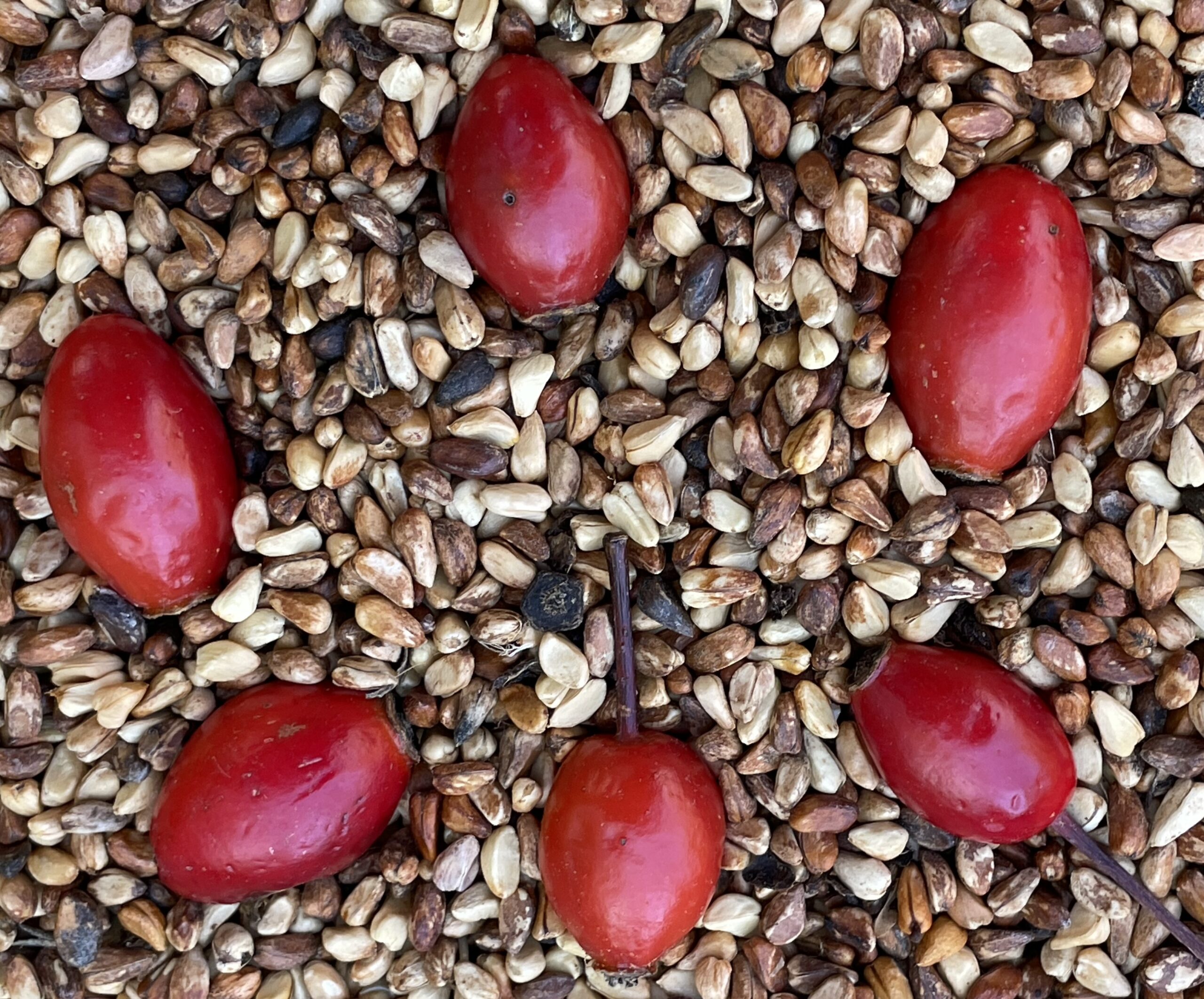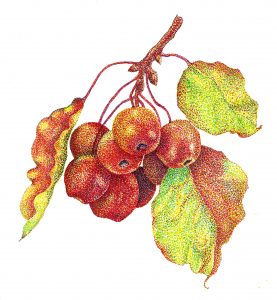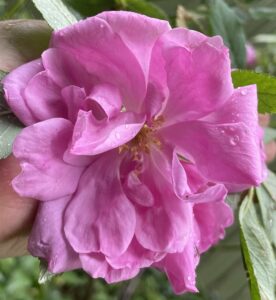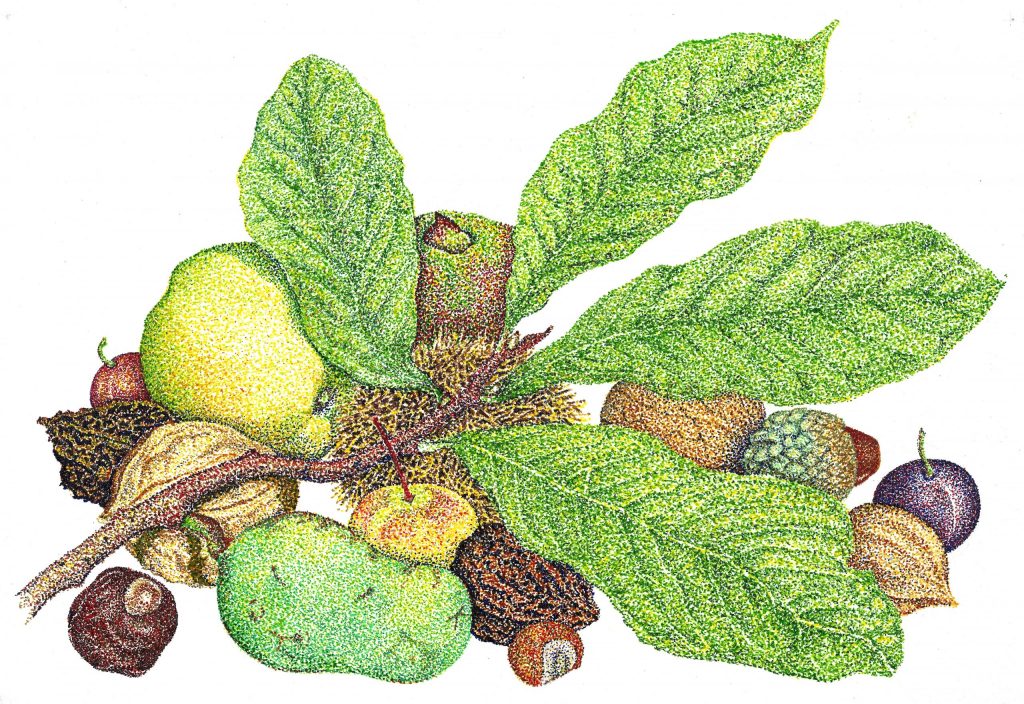Experience-Seeds-Knowledge-Plant Discoveries-Ecological Enrichment-Join Now Click Here!


The Unexplored Explored: Minor Becomes Major

One of the most exciting and little known areas of fruit growing falls into the category called minor fruits. When I first started publishing my catalog in the early eighties, the minor category was front and center. The unknown possibilities of minor fruits are the unexplored. To me it was very exciting. The category name implies a certain insignificance too. It might have regional significance like beach plum or thimbleberry. Soon my whole catalog was minor fruits so I discontinued this category name. Another category in the same ballpark was Native. That category became nebulous over time as it meant so many different things to people. What made it even more confusing were the conservation industries. But certainly many native North American indigenous fruits are in the minor camp. Pawpaw is making a slow exit out of the minors. Our knowledge about minor plants is also minor. This in itself is a big deal because you have to ask yourself what are you going to do with this fruit. Within a party of major fruits, you are a novelty and set aside. Today you can find champions of the minor fruits within social media where birds of a feather flock together. There are no formal organizations or commercial industry that would champion your fruit and its benefits to the world at large. Yet at the same time the ‘minors’ may be heralded by crop diversity experts. Some of these minor crops are getting a make over with interest from many different regenerative agriculture organizations. Yet rarely by actual farmers as a means for larger production. Within crop diversity, they may be realized as crops with important genetic resources needed for a changing climate. They make contain a certain nutraceutical characteristic desired or needed by many. Aronia, elderberry and black currant are these types of plants. A few years ago my farm was visited by representatives from the Crop Trust organization where finding and harnessing wild crops plays an important role in creating healthy food for farmers in the U.K. Is that cool or what? It is not easy creating a crop from scratch. Breeding really is the smallest part of it. Its a bit much to ask a farmer to convert a field of annual crops to perennial crops when there will likely be no income for three years or more. Who is going to pay the taxes and provide the cost of establishment of that new crop? This could be true for apples, pecans or raspberries. This was a stumbling block for farmers in the U.K. I would imagine it would be the same here in the U.S. But for the small farmer, this could be an adjunct to existing crops or a means to create additional income in a higher value market.

From a production stand point in a nursery, I found minor crops much like the wild plums I cultivate to be cult classics. It was exciting to be the first. They were novel ideas put into action from discovery to seed production to then plants to the retail market. I think it took a whole countries to bring the edible honeysuckle, honeyberry into fruition. Frankly, for me as a lone operator there was not a lot of money in it. In some ways it was too specialized with a limited audience unless it has been found in the crosshairs of the conservation industry and it needs to be removed. Some of these minor fruits may have a weedy relative somewhere. It could cause a collective sort of vapor lock on what to do. What advertisement your fruit may get, will be negative. Berberis, Elaeagnus, Ribes, Pyrus and Morus are a few to mention. When I ran my nursery, I was constantly checking the National Plant Board for regulatory issues with the minor crops. Ribes was particularly problematic. Recently I see hardy kiwi ended up in those cross hairs. Ouch. There is also a new category called a ‘watch list.’ This is the “I got a TV eye on you” fruit. Thank you Iggy Pop and the Stooges for that line. Don’t expect science to play much of a role in these decisions.
Yet this is a wonderful and ideal place to be. Ignored, shunned and even degraded to a degree is the perfect time to start a collection and breeding. Or you could just make something delicious and enjoy it. Your fruit has not been ruined yet by large scale breeding or a fruit industry hell bent on a very narrow goal. It puts you in the driver seat. You might forage it like mulberries or maybe you will even grow it. A lot of fruits are in this minor fruit category and more are added every year. A few have left the group and are slowly making their way to the tables of consumers. Lets face it, its not easy being a new fruit on the block. People pick on you rather than pick you. Here are a few of my favorites and some surprising discoveries and potentialities at my farm that I have discovered in the last forty years.

The Rose We All Love: Petals, Seeds and Fruit
It is easy to fall in love with the rose. On all levels it is beautiful plant providing a fruit, petals and fragrance. It is a universal plant with universal appeal. The fruits, seeds and petals are also an agricultural commodity. The petals and hips for food, the seeds for oil used in cosmetics. The plant is heavily used for its ornamental appeal. I remember reading many years ago that 25 percent of all plant sales were roses. Huge farms of them are commercially produced in the southern U.S. I am not sure what the stats are today but it appears the shrub roses are showing up in landscapes now. There are many patented varieties in the ornamental trade and a new variety grown for its edible petals. It is a Proven Winner plant produced by Spring Meadow Nursery. I did notice the petal market is mostly wild collected dog rose, Rosa canina. I purchased a bag of the m at my local food coop. It was special order! I used the petals to make a jam. It has a calming effect and can be added to warm milk at night to help as an aid to sleep. I have noticed a great difference in flavor on all the different species roses I have. For a while I collected seed anywhere I could and even created a variety for petals called ‘Mary Jo’.

I also exchanged and used seed wild collected from species throughout the world. Eventually I found some selections of a species called Rosa villosa. Here the hips were big, stayed in good quality on the shrub and were very heavy bearing in Michigan. The big bonus was they tasted delicious. I found others too but so far, this species is amazing as it has good flavor even off the bush. I tried Rugosa rose and many others based on individual countries and their usage in certain regions. I collected many types of native roses in Michigan when I went on vacation with my family. These were very good but the flavor and low yield were not very good under cultivation. I guess that might be the issue. Location, location and location. Fruits like rose hips taste better in the wild than they do cultivated. Even so the selections I made consistently have a great flavor and yield. It is possible to cultivate like any fruit crop. As much as I wish, the make a better mouse trap theory, does not apply to roses. There are so many great roses out there, you are soon swallowed up in beauty and fragrance and your fruit rose is pretty much neglected. Its a good field to stand in though. Only single petals….too bad. Only pink color…..too bad. There is fruit…..too bad. Its a species rose……death by species….too bad. ‘Tough crowd’ as Rodney Dangerfield use to say. He also had another saying I would like to apply to the nursery trade related to roses, “Boy I bet you were something before electricity.”

The Viburnum of All Raisins
All viburnums are good. I love a plant that has an ornamental appeal with heavy fruit production even if it not meant for human consumption. Keep in mind it’s a busy world being in the Viburnum business with many patented varieties. If you go to Spring Meadow Nursery website you will find massive amounts of them. Arrowood viburnum rules. I have a few of those at my farm now because my neighbor had a landscaper install some. The fruits are important but their ornamental appeal is directed to the birds or possibly the display of fruit in the fall. It’s kind of cool.
In the case of blackhaw viburnum no clonal selections are available. Yet it is one of the most delicious. I love the raisin flavor. You can enjoy it directly off the bush. In this same edible raisin camp is Viburnum lentago, Viburnum carlesii, Viburnum mandshurica and Viburnum cassinoides. All of these produce delicious bits of raisin like fruit surrounding a bony seed. But keep in mind it is often considered a ‘nibble’ fruit with little fruit around the seeds. Sometimes it seems like its only a few molecules of flavor too. Birds yes, people not really. But it is the blackhaw that really tops the list for both yield and amount of that raisin like skin around the seed. It is by the far the best in this arena for cultivation. Many years ago, a customer of mine who was familiar with this species and others found a correlation between size of the plant and overall vigor and yield of fruits. That might seem obvious but what he was talking about was something far outside most seedling plants of that species. It was like finding the sequoia of Viburnums.. This was my experience as well as I began to grow out various ‘prunifolium’ seed sources. I discovered that many nurseries were rooting them instead so the genetic diversity was nil. Viburnum lentago or Nannyberry was used extensively for wildlife plantings but for me this species could not survive long outside of its native wetland habitat or had to be irrigated. All of mine slowly perished within a decade.
Eventually I purchased seed of an Iowa form of prunifolium from a seed company and planted two pounds of seeds. The seed quality was very low. They evidently were too dried out. Only a few plants grew after two years. Rather than sell them, I planted them in a row in my outback near my hybrid oaks. The seed species said ‘rustifolium’ on the tag but it was not the southern blackhaw as the distinct morphological characteristics did not match. I noticed right away there was significant differences in growth rate. As predicted the fast growing ones survived and flourished on my dry sandy sight. The tallest and single trunk trees proved to be the heaviest yielders as well as being the forms that spread via stolons. There I began thinning them and making it possible to walk though my mini forest of blackhaws all in the shade of the hybrid oaks. In the world of Viburnums, it was spectacular.
There comes a point where you might ask yourself, “what is the purpose of this of this fruit if I am the only one that enjoys it?” Without having some sort of bigger picture in mind and a means to champion the fruit to a bigger audience, it too will be the cult classic. If you tell someone in the fruit industry you can produce it from seed, then that in itself is the kiss of death for some. Yet that is exactly what I would do if I planted an orchard of it. This makes it easy to direct seed on basically a cultivar level plant from seed. But even if you do decide cloning is the way to go, that is still a wonderful idea as the tree naturally does this for you. So its win-win. Iowa is that selection based on those traits. This is why I chose this sequoia of fruit production from a well known and unselected population. Iowa represents this selection process of a little known minor fruit. “Its more than a few molecules” is the tag line here.
The Autumn Olive Becomes the Autumnberry
I love autumn olive. I love the scent of the flowers, the delicious tart fruits and the wonderful things you can make from it. When in season, I love it fresh and eat some every time I go for a walk. I view it as a valuable tool to create health with its high antioxidant fruits high in lycopene. I never really had a chance grow the fruit in great numbers. It was firmly in the wildlife camp at the time of my nursery and offered by the conservation districts where millions were sold and planted.
Many years ago, at a North American Fruit Explorers conference I met Hector Black of Hidden Springs Nursery. He found pretty much by accident huge amounts of an antioxidant called lycopene within the fruit. This is the primary antioxidant found in tomatoes. He collaborated with the USDA and they published a study on these findings and the variations found within the fruit. Having a fruit with twenty times the lycopene as tomatoes was quite a big deal at the time. They had suggested the name autumnberry to both highlight its use as a human consumed fruit and educate people that it was not an olive. Further studies showed anticancer compounds within the seeds as well as the benefits of its nitrogen fixing properties for walnuts and oaks. It was here I began looking for fruits of the plants on my family tree Christmas tree farm and began making some selections. I began to grow the goumi relative and found there was a small market for that plant. Just prior to the regulations changing I sold selections of autumnberry. By then the campaign to eradicate it was in full swing and that door closed shut. Due to its abundance to begin with, it was not popular anyway. My thought was it could be combined with seaberry, aronia, black currant and elderberry as a source for a healthy juice drink. From here it went to those using wild collected fruits and experimenting with cultivar development and selection. Selections are available now but only from areas of the country it is not considered invasive. In Michigan it is not permitted to grow and sell the plants with a sliding scale of fines from one to ten thousand dollars. But people enjoy it and still pick it and use it for fruit roll ups and syrups. In the meantime, nature has other plans. This plant will easily be with us despite the love of herbicides by well intentioned but misguided land managers and the organizations they represent. That part is a sad story actually. They believe they are using a form of chemotherapy of the land called Round Up. That truly is a sickness but no worries; autumnberry can help them with that too.
Pyracantha is the Firethorn-Orange Cones
I remember the introductions of this plant in the landscape trade in the eighties when I first started working for a wholesale company. Every design contained Pyracantha. It was Monrovia Nursery in California that produced vast quantities of it. The selections with the large clusters of bright orange berries were a delight to see in the fall. It was often sold with a trellis attached. It was considered a bird fruit. I tried eating it a few times. I was not sure what I was experiencing as it appeared to have little flavor. Today I cannot find a single living plant in my area in any landscape other than the few at my farm. The well bred named varieties are long gone. The fireblight resistance must of wore off at least in Michigan. We called it ‘toasted’ back then because fireblight turned the plants black. What probably wore off the most was the thorniness. One of my colleagues of mine kept sending me seed of numerous species, crosses and varietal selections. He was bullish on pyracantha. Skeptical, I grew and tried to sell it for a while but few wanted the thorny plant despite its evergreen nature. My workers hated the plant in the greenhouse. The thorns were ruthless. In the meantime, I took the remaining plants and planted them on a very unforgiving hillside. There the soil is sand dune with rocks. About twenty years went by and this fall I finally noticed the fruit. This time armed with an actual jelly recipe I plan to attempt to make something of the fruit. I am more hopeful I will enjoy the flavor. I am hoping it will look like my grandmothers giant molded orange Jello salad with the small white marshmallows in it. It was bright and could be seen for miles around. You could direct traffic with that salad.
Pie Pear From Florida-Pie in the Sky
It began with a phone call from a customer who grew up on a farm near Flint, Michigan. She was now in Florida and found great delight in harvesting and using wild fruit in her family’s farm hedgerow in Florida where her son lived. This pear was a local favorite used to make pies in the fall. It had one use and one use only: Pie. She sent me a box of pear fruit which leaked big time right through the box. The fruit had bletted in transit. The folks at the post office mentioned the floral fragrance to me. The box was subsequently wrapped in plastic. Apparently the fruit juices were everywhere in the parcel delivery area in back. As I hastily left the lobby area, I tried not to look too guilty.
I extracted the seeds and grew twenty or so trees. The Florida pears did well in Michigan. No one from Florida moves to Michigan for the winter but the pears seemed happy. They hung on to their leaves very late and developed long fruiting spurs. The first year of pruning reminded me to wear gloves. The second year was to get better gloves. Eventually when the fruits came on I tasted a few realizing in the fresh state they were close to impossible to consume. The astringency was off the charts. As they began to turn to mush on the tree in November, the flavor began to change to a very tart pear flavor with the floral characteristics found in the post office many years earlier.
Could this be a native pear to North America? Most would sat probably not but I would love to get a DNA profile done to see what sort of shenanigans this pear has been up to. It is very unique and different than any cultivated pear I have ever grown and I have a lot of species at my farm. I have a friend in the landscape trade that found a dwarf hackberry on a college campus. He had it DNA tested. His find was far outside its native range. He was right. It was a new species in this area. How can a pear survive Florida? The humidity, heat and limited chill hours would seem to doom all pears in this geographic region. Yet here they are thriving on their own. What to do? Make a pie!
Once fully ripe you squeeze out the pulp leaving the skins behind. Probably best to not use the skins because of their astringency. The fruits have a lot of grit cells. I was using a Vita-Mix to whiz them up to break down the grit cells so it was more creamy and less sandy. It was gritty, not pretty due to those calcium stone cells. Sugar was needed to calm the whole thing down. I made a jam out it that you could bounce a bowling ball off off. It was delicious despite its neutron star density. Thank you Pie Pear Lady wherever you are. I made one selection from this group that had larger fruit and was extremely productive. The name? “Pie-In-the-Sky” Coming to a post office near you!
I got a TV eye on these fruits.
Enjoy. Kenneth Asmus
